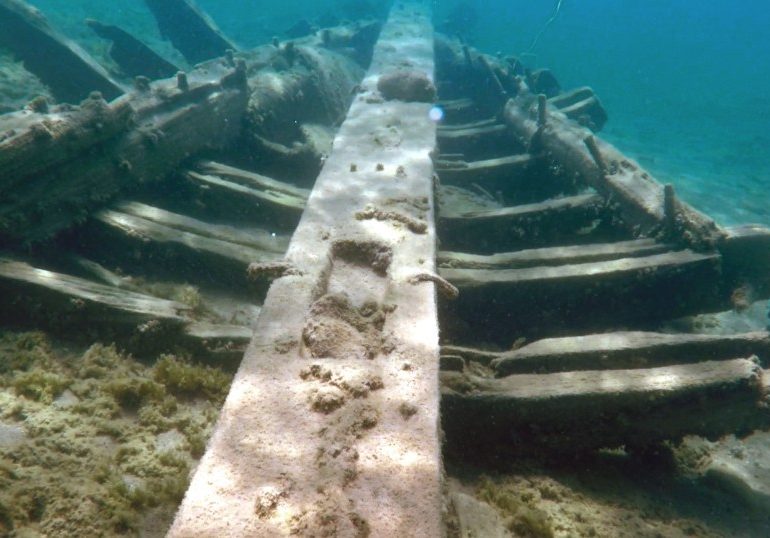THE mystery behind a “cursed” shipwreck was finally solved 350 years after it vanished during its maiden voyage.
The Griffin, which disappeared carrying a valuable cargo in 1679, was identified by a couple of shipwreck hunters.
Credit: Great Lakes Exploration Group via Pen NewsThe Griffin has been identified nearly 350 years after it vanished[/caption]
Credit: Great Lakes Exploration Group via Pen NewsSteve Libert diving on the ship and discovering the keelson[/caption]
Credit: Great Lakes Exploration Group via Pen NewsThe ship was rumoured to have been cursed by native tribesmen[/caption]
Steve Libert and his wife, Kathie, claim that they have found the infamous vessel.
The ship was built by the French explorer Rene Robert Cavelier, Sieur de La Salle with the goal to sail through uncharted waters where only canoes had previously gone.
The Griffin was the first and biggest at the time vessel to enter the Great Lakes beyond Niagara falls.
But it vanished without a trace with all six crew members and a valuable load of fur – estimated to be £640,000 in today’s money – onboard on its return journey.
Rumours have long circulated that the Griffin had been cursed by the Iroquois tribe’s prophet.
The vessel became a “holy grail” for shipwreck hunters since its disappearance with many attempting to discover its resting place.
Steve and Kathie believe that they are the first ones to uncover the ship’s whereabouts.
They published their fascinating find in a new book, Le Griffon and the Huron Islands – 1679: Our Story of Exploration and Discovery.
Steve said: “Our extensive research and deciphering of historic documents led us precisely to the resting place of an undiscovered colonial-age ship.”
The couple claim that the wreckage found in 2018 near Poverty Island, Lake Michigan, matched well with the description of the Griffin.
They also believe a bowsprit discovered a few miles away in 2001 is another component of the ship.
The Griffin’s owner, La Salle, stayed behind on the island where the ship briefly stopped and never learnt the fate of his vessel.
But multiple theories have sprung up over the years, speculating what might have happened.
Steve said: “Father Louis Hennepin said it was lost in a violent storm.
“Some say that the native Indians boarded the ship and killed the crew. They then set the ship on fire.
“Many believed the Jesuits were responsible for the ship’s disappearance.
“La Salle was certain that the captain and his men committed mutiny, sank the ship and absconded with all the furs.”
According to one legend, the Griffin was cursed by Metiomek, an Iroquois prophet, who predicted La Salle and his ship’s demise.
Metiomek apparently told him: “Beware! Darkness like a cloud is ready to envelop you.
“The Christian Indian’s curse rests on you and on your great canoe.
“She will sink beneath the deep waters and your blood shall stain the hands of those in whom you trusted!”
As per native’s traditions, the Griffin became a ghost ship, sailing through the moonlit skies as crew can sometimes be heard chanting.
Steve explained: “Both the Seneca and Iroquois felt threatened by the construction and sight of Le Griffon, and felt that it was a threat to the ‘Great Spirit.’
“The Seneca were in awe of the French for having built such a large canoe. They were concerned for their safety in as much that they tried to burn the ship during construction.”
Just as the prophecy foretold, La Salle died at the hands of his own men during a 1687 expedition and his ship sank.
But the evidence suggest that it was a severe storm that brought about the end of the Griffin.
The vessel was reportedly caught up in a four-day storm in which its bowsprit broke off from the rest of the ship.
Steve said: “The distance of 3.8 miles between the bowsprit and main sections highly suggests the Indians did not sink it either, nor did La Salle’s men mutiny and sink the ship.
“If any of the latter was true the ship would rest in deeper water instead of shallow waters.”
The bowsprit’s carbon dating indicates an age range that is within a year of the sinking.
A rough dating of the remaining wreckage places it between 1632 and 1682.
Steve, who dreamed of finding the ship since learning about it in history class as a kid, didn’t have an easy path to his discovery.
The search efforts were delayed because of a 10-year legal battle with the State of Michigan, preventing explorers to excavate the site until 2013.
Michel L’Hour, a French archaeologist, dubbed “Indiana Jones in a diving suit”, put forward a theory that the rest of the ship was nearby.
Steve then spent two years going through satellite images before his breakthrough.
He found the keelson and frames of the vessel and the dive in September 2018 confirmed his suspicions.
He said: “I was emotionally drained of all my energy, and was in a complete state of relief and exhaustion, but I could still yell out the words “we found it!” once I broke the surface.
“Michel was spot on when he said the main body of the wreck would be within four miles of the bowsprit.”
But the state continues hindering the process as the pair are still banned from conducting an in-depth excavation.
Mr Libert said: “I believe the state feels we are encroaching upon their sovereignty and feels we are nothing more than treasure hunters intruding on the rights of academia and archaeologists.
“But we can systematically search the bottom using non-intrusive techniques and remote sensing devices for conclusive diagnostic evidence.
“It is just a matter of time before we achieve our goal. Possibly a cannon, hopefully with the date stamped on it.”
Credit: Great Lakes Exploration Group via Pen NewsThe shipwreck hunter made a shocking discovery during a dive in 2018[/caption]
Credit: Great Lakes Exploration Group via Pen NewsPhoto shows a gripe plate attached to the keel[/caption]
Leave a comment








